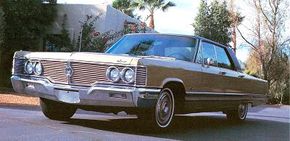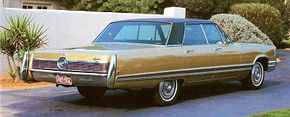The 1967-1968 Imperials abandoned the separate body and frame construction for good. Ostensibly, the reason was technological. By 1967, Chrysler argued, methods of insulation and soundproofing had become so advanced as to make the use of a separate body unnecessary.
Advertisement
Vast technical improvements had indeed occurred, allowing computerized stress testing of the unit body/chassis before its construction. As a bonus, the unibody also reduced average weight by 100 pounds or so. The 1967 Imperial, the company said, was if anything quieter and smoother than the 1966.
Another compelling reason for the change in construction technique was overhead: It was certainly cheaper to build unibody Imperials with a Chrysler inner shell, albeit on a slightly longer wheelbase.
As a result of this basic change, the 1967 models were all-new and completely restyled. A new grille with a prominent nameplate was accompanied by sharp front fenders that housed the parking lights. Headlamps remained integrated with the grille. There were vertical rear bumpers and horizontal "character lines" along the bodysides. The wheelbase came down two inches to 127.
Sales did pick up, exceeding 17,000 in 1967 and 15,000 in 1968. Prices also rose, Crown hardtops exceeding $6,000 base for the first time. To compensate, Imperial reinstated the Crown four-door pillared sedan, which started at around $5,400. Convertibles remained, but just barely: production was only 577 for 1967 and 474 for 1968, the last year for the Imperial soft top.
Imperial's continued inability to dent the Cadillac/Lincoln market share caused management to rethink their approach and make a far-reaching decision. For 1969 and beyond, Imperial would share exterior sheetmetal with Chrysler.
The 1968 Imperials, meanwhile, were only slightly changed from 1967. Features included a new grille that extended around the front end to enclose the parking and cornering lights, dual moldings on the lower bodysides, and rear side-marker lights (now required by law). Narrow paint stripes were applied along the beltline on all models. The 440 V-8 remained standard, with a dual exhaust/twin snorkel option that boosted output from 350 to 360 bhp.
Learn what the critics thought of the unibody 1967-1968 Imperial on the next page.
For more information on cars:
- Classic Cars
- Muscle Cars
- Sports Cars
- Consumer Guide New Car Search
- Consumer Guide Used Car Search
Advertisement


